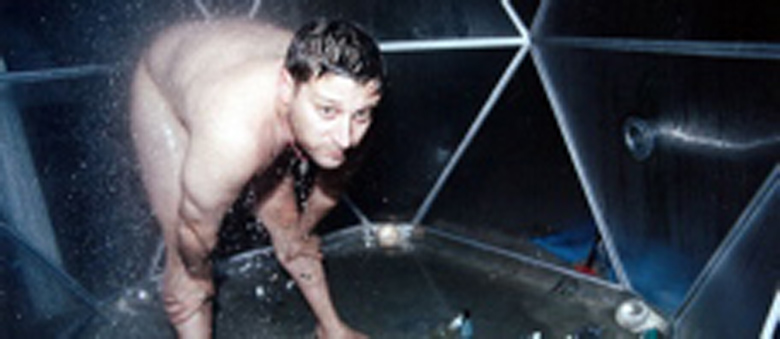Reviews
Ondi Timoner
USA, 2009
Credits
Review by Leo Goldsmith
Posted on 27 March 2009
Source Digibeta
Categories The 2009 South by Southwest Film Festival
New Directors/New Films ’09Visibility is a trap.
—Michel Foucault
Ondi Timoner’s last documentary, Join Us, picked over the perversions of an abusive church cult in South Carolina; her first major film DIG!, about The Brian Jonestown Massacre, documented as much sex, drugs, and idiocy (especially the latter two) that one can reasonably expect from a rock band with a renowned proclivity for heroin. We Live in Public, her new film about forgotten internet pioneer, New Media mogul, and sometime “cyber kid” Josh Harris, is kind of a hybrid of the two, equally a documentary about group-think control and unbridled, child-like idiocy. And curiously, it finds that these two seeming opposites are not quite so contradictory, after all.
Indeed, Josh Harris and BJM’s Anton Newcombe are both overgrown children and precocious geniuses (or “geniuses”) in very ways, but each doggedly, even pathologically pursues his ends with a nearly superhuman extravagance and degree of hubris. Of course, the primary difference between the two is that Harris became massively wealthy in doing so—before he imploded and became massively in depth. Gradually building an internet media empire while the world was still dialing-up and buffering, Harris soon aspired to be what one interviewee describes as “the Andy Warhol of the Internet,” attracting diverse, off-the-wall talent to host shows at his trailblazing Web TV-station Pseudo.com, wooing wealthy, bubble-minded investors, and openly menacing Viacom during his 60 Minutes profile.
In many ways, Harris’s achievement was the result of an astonishing prescience—in the future, he augured, people would watch TV, communicate with one another, and essentially live their lives on the internet, and although there did not yet exist the technology to do all this, Harris and his empire forged ahead anyway. (An early digitally animated video piece by Harris entitled “Launder My Head” shows a group of people with monitors for heads chanting things like “Come form with us” as they dance in digital lockstep, à la Ally McBeal’s atrocious dancing baby, in an austere, blocky landscape that uncannily resembles “Second Life.”) But of course, Harris was also lucky (or, arguably, unlucky), a recalcitrant, socially stunted kid with a bit of vision, a lot of computer-savvy, and an odd predilection for Gilligan’s Island, who simply found himself in the right place at the right time.
But then, Timoner found herself at this same place and time, and the moment she documents is extraordinary. Buoyed by the dotcom bubble, and already frightening investors and showing signs of wear and/or megalomania by dressing up as a menacingly sweet-natured clown called “Luvvy,” Harris begins a series of social experiments to test his theories about the internet and the technological fate of human civilization. The first of these experiments is “Quiet,” wherein one hundred people are confined to an underground capsule hotel for the month before Y2K, given as much free food, booze, drugs, and (for some fucked up, ill-advised reason) loaded firearms, on the condition that their entire lives underground are filmed 24-7 and broadcast for all the other citizens to see. “Who says that’s necessarily bad?” Harris openly wonders about his fascistic panopticon, which also features an interrogation room used to collect information from the citizens. In the land of Quiet - which, with the firing range downstairs, is anything but - there’s always plenty showering, peeing, screwing, shooting, and revelry to watch on the many monitors, prompting one of the citizens to note that “We’re all vastly more fascinating to watch than television.”
But as perverse and weirdly totalitarian as it was, Quiet was also weirdly prophetic, a very early experiment in the kind of social-networking and data-mining that people now conduct (or resign themselves to) on Facebook, MySpace, Twitter, and Skype. As Harris later notes, the experiment was an early model for how the internet “trains people to automate themselves,” to offer up information about their lives, spy on one another, hide inside the performed, visible selves that they’ve, in essence, created for the cameras. And following Quiet, Harris took this experiment one step closer to home, turning himself and his live-in girlfriend into the lab-rats in “We Live in Public.” Harris wired his entire apartment for streaming video so that random onlookers from across the internet could eavesdrop, comment, and virtually contribute to their day-to-day lives. Yes, showering, peeing, screwing—but also squabbling and deteriorating as a couple, all while the Harris’s fortunes decline, the bubble bursts, and the 1990s come to a screeching, thunderous, smoldering halt.
Here as in DIG!, Timoner shows her good fortune in finding subjects who are both resonant and sufficiently crazy, as well as her presence of mind to document their activities over a fairly long period of time. But this serendipity is also matched by consummate skill in filmmaking, and with We Live in Public she bests her prior work in crafting a documentary of ideas that is also massively fun - and increasingly unnerving - to watch. Of course she was in the right place at the right time, but in an age when we expect our documentaries to give us instant historicization, to inform us about everything that happened last year, yesterday, and right up to this very minute, Timoner’s film offers a refreshing and ultimately quite disturbing step back from the maddening rush of the now. We Live in Public is sharp and elegant in its construction, and its long, leering look at the late 1990s feels much more urgent and relevant than any number of quickie documentaries that strive for currency.
More New Directors/New Films ’09
We don’t do comments anymore, but you may contact us here or find us on Twitter or Facebook.





